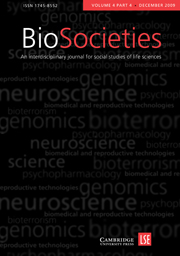Article contents
Critical Neuroscience: Linking Neuroscience and Society through Critical Practice
Published online by Cambridge University Press: 01 March 2009
Abstract
We outline the framework of the new project of Critical Neuroscience: a reflexive scientific practice that responds to the social, cultural and political challenges posed by the advances in the behavioural and brain sciences. Indeed, the new advances in neuroscience have given rise to growing projects of the sociology of neuroscience as well as neuroethics. In parallel, however, there is also a growing gulf between social studies of neuroscience and empirical neuroscience itself. This is where Critical Neuroscience finds its place. Here, we begin with a sketch of several forms of critique that can contribute to developing a model of critical scientific practice. We then describe a set of core activities that jointly make up the practice of Critical Neuroscience as it can be applied and practised both within and outside of neuroscience. We go on to propose three possible areas of application: (1) the problems related to new possibilities of neuropharmacological interventions; (2) the importance of culture, and the problems of reductionism, in psychiatry; (3) the use of imaging data from neuroscience in the law as alleged evidence about ‘human nature’.
Keywords
- Type
- Articles
- Information
- Copyright
- Copyright © London School of Economics and Political Science 2009
References
- 136
- Cited by


